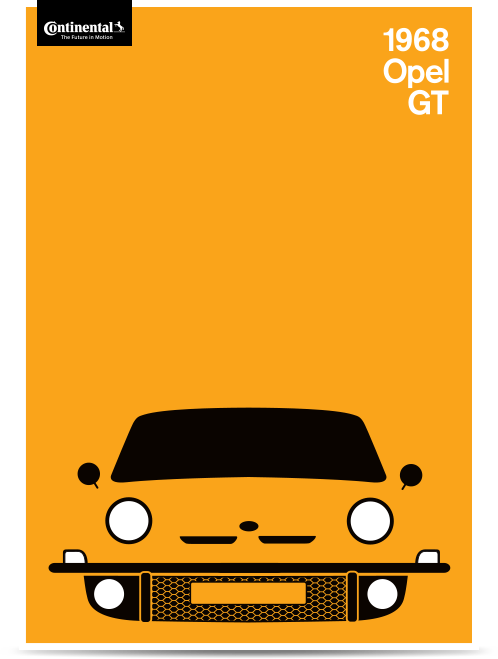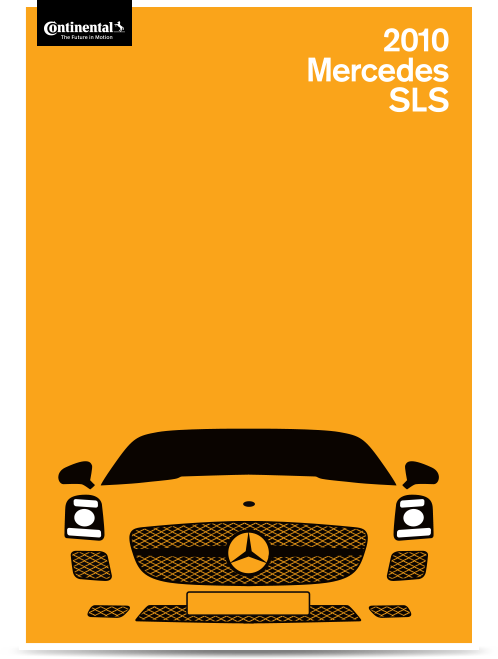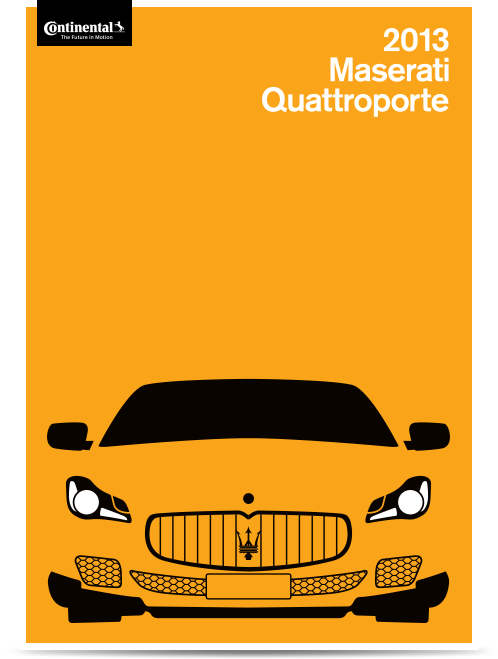Every chapter of our history as a tyre manufacturer is closely entwined with vehicle manufacturers and we’re proud to have been present during the most defining moments in automotive history. These are the moments when pioneering vehicles rolled off the production lines, each to make a mark on the world in some way. They would redefine automotive excellence, introduce innovative technologies and even go on to become symbols of cultural change.
To help celebrate 150 years of Continental Tyres, we commissioned New York based artist, Julian Montague, to produce a series of artistic tributes to our ‘OE Heroes’. Julian has taken the defining lines of these iconic vehicles and brought them to the fore. Each ‘OE Hero’ has a special place in automotive history and, of course, each of them was launched with Continental as original equipment. We present to you, our OE Heroes…

1901 Mercedes 35PS
The first car produced by Wilhelm Maybach and Paul Daimler under the name Mercedes, the Mercedes 35PS was launched in spectacular style, dominating the famous Nice Race Week. Arguably, the most enduring feature from this vehicle is its shape. At the time, it was incredibly innovative, with the radiator integrated organically into the front end along with the engine, which would drive the rear wheels This would go on to become the conventional car setup we are familiar with today. The Mercedes 35PS was fitted with Continental pneumatic tyres - themselves revolutionary at the time.

1950 Volkswagen T1
The Kombi. No other vehicle is more closely linked to freedom than the Transporter T1, which would go on to help define the image of the 60’s hippy and counterculture movement in the United States. Even today, it remains a symbol of anti-establishment thinking and wanderlust. Not as exciting but all the same enduring, the T1 legacy lives on in modern cargo and passenger vans. The T1 was the originator of this class of vehicle but there’s no denying the real fame comes from that link to freedom and the thrill of the open road.

1955 Volkswagen Beetle
The Beetle had already been around for 8 years and was doing well, when a series of refinements saw VW release what some believe to be the classic Beetle. The ‘55 Beetle included the introduction of a second exhaust, an upgraded bumper and electrical direction indicators for the first time. For the driver, the seats were widened and could now be reclined into 3 different positions.

1964 Porsche 911
It might be the most famous sports car of all time. It certainly has one of the most distinctive shapes in Automotive history, a shape that has endured from the original 911 in 1964 to the modern-day incarnations. You can look at any of the 911 models and you know instinctively what it is. That’s the genius of the design. As for driveability? Many will argue a Porsche 911 provides the most enthralling, visceral driving experience of any supercar.

1968 Opel GT
Well known to enthusiasts, the 1968 Opel GT has never received the level of adulation it really deserves. The styling is playful and unapologetic. Then there are the quirks of operation. Like the pop-up headlights that rotated counterclockwise when you manually pulled the large lever in the centre console, by the gear shift. It all makes for a sports car that is unlike anything else.

1974 BMW 2002
The name stands for ‘two-litre, two door’ and the arrival of the BMW 2002 would introduce a new category to the motoring world; the sports sedan. The small frame contained a big car performance that was expertly controlled with some of the most agile handling experienced in a car to date. It was a revelation and rightly lauded by the motoring press. Every sporty sedan we have today owes a little something to the legacy of the 2002.

1974 Volkswagen Golf 1
Another vehicle that created its own category, the VW Golf is undoubtedly the progenitor of hot hatches. The Mark 1 was designed by Giorgetto Giugiaro and showcases his signature ‘origami’ style of the time. Those looks have been present in virtually every iteration since and continue to define what a hot hatch should look like. This is a car that just looks sporty. Instinctively, you know it will be fast, nimble, and able to navigate narrow roads at high speeds.

1975 Opel Manta
The GT/E edition of the Opel Manta has a reputation for providing some of the sportiest handling available. We like to think the choice of Continental as OE helped that legendary ability to stick to the corners. Either way, the Manta was a magnificent vehicle and when a fuel injection system was introduced in 1975, it was faster than ever. A driver's car, the Manta may not be as recognisable as others but it is nonetheless worthy of a place in automobile history.

1980 Audi Quattro
When Audi took advantage of a rule change to release a four-wheel drive rally vehicle in 1980, they changed the course of rallying history forever. At the same time, they introduced the world to what would become one of the most revolutionary sports saloon cars of all time. Very few vehicles would get as many people excited when seeing one pass by. Driving one was something else altogether, the exhilaration from the ride and that 4-wheel drive system would transform any Sunday excursion into a thrilling adventure.

1983 Audi 80
Part of an Audi family that went into production in 1966, the ‘83 Audi 80 was the first model available with four-wheel drive. There were echoes of the by-now famous Quattro in the styling, particularly on the 80 Sport model. The UK variation featured the distinctive ‘Audi Sports’ stripes, along with a rubber rear spoiler and Quattro-styled Ronal alloys. It might not be the fastest Audi of the era but it remains arguably the most aesthetically pleasing.

1986 Land Rover D90
Similar to the legendary Land Rover Series 3 in appearance, the D90 (Defender 90) had a 93-inch wheelbase and more than a few mechanical improvements, including coil springs and a permanent 4-wheel drive system, which was taken from a Range Rover. It was the first Land Rover to be marketed by the company as a private recreational vehicle and would introduce a generation of drivers to the wonders of off-road capable vehicles.

2001 BMW Mini
Few car marques command as much loyalty and enthusiasm as the original mini. It was a symbol of the swinging 60s and so utterly distinctive. Yet in 2001, BMW succeeded in recreating the magic. Somehow they managed to reinterpret the original lines into a modern vehicle that was simultaneously visually connected to the original and very much its own car. It breathed new life into the Mini brand which has experienced continued success ever since.

2002 Porsche Cayenne
The first Porsche with 4 doors, and the first off-road Porsche since they made tractors in the 1950s - the Cayenne is the original luxury crossover SUV. It introduced a new generation to the eminent drivability of Porsche, as it delicately but precisely blends sports car handling with everyday drivability and comfort. It is now one of the best-selling Porsche models and is often considered the most affordable (and most practical) for many drivers.

2005 Porsche 9FF
Only 150 exist, so if you catch a glimpse of a 9FF on the road, consider yourself very lucky. You might not get too much of a chance to appreciate the subtle differences from the 911 though - as the reputed fastest street-legal car in the world, the 9FF is capable of accelerating to 300 km/h in under 16 seconds. To help keep control at speed this very special Porsche comes with Continental as original equipment.

2010 Mercedes SLS
Billed as Europe’s ‘most attractive car’ by Auto Bild magazine, the 2010 Mercedes SLS is the spiritual successor to the fabled Mercedes Gullwing (although it is actually a replacement for the Mercedes McLaren). Assistance from former F1 driver David Coulthard established the driving credentials whilst the world's fastest naturally aspirated engine powered the SLS to a top speed of 315 km/h established supercar status, with the SLS taking just 3.8 seconds to reach the 100 km/h mark.

2011 Renault Twizy
From speed to pure EV quirkiness, in one of the most distinctive designs ever from a major automobile manufacturer. The Twizy is a unique urban electric vehicle that sits just 1.25 metres wide and can turn in 3.5 metres. Perfect for tight City streets and even tighter parking spots, Renault developed a futuristic concept car that is as much fun as it is functional.

2012 Tesla Model S
The first electric vehicle to ever make it to the top of any country's monthly sales rankings, the Model S was the Tesla model that changed the way the world would drive. That change might still be happening but the Model S proved EVs can be both practical (with an extended KM range of up to 647 kms) and attractive to drivers, winning multiple awards along the way and revolutionising the automobile industry.

2013 Jaguar F Type
The first 2-seater sports car built by Jaguar since the iconic E-Type is a masterpiece of design from the revered and refined styling hand of Ian Callum. The lines are undoubtedly Jaguar and seemingly trace the English automobile manufacturers lineage from their iconic past through to the F-Pace. You don’t need to see a badge to know this is a Jaguar. Yet it’s equally undoubtedly a modern automobile as any driver would appreciate when they press the accelerator. The F Pace will reach 100km/h in 3.5 seconds.

2013 Maserati Quattroporte
Designed by ex-Pininfarina designer, Lorenzo Ramaciotti, the Quattroporte has one of the most elegant and distinctive grills in motoring. It’s befitting a model revered for handling and an ability to blend sports car performance characteristics with the refined luxury of a large sedan made for long journeys and total comfort

2017 Honda Civic Type R
From any angle, the Civic Type R screams fun and excitement. There is no doubt this is a car made to delight the driver and possibly scare the passengers, just a little bit. Keeping things in control are Continental SportContact 6 tyres, a perfect base for a hot hatch that is unapologetically racey. There is nothing subtle about the Civic Type R, which is precisely why it has become such a favourite in recent years.

2017 Rolls Royce Phantom
The trademark Rolls Royce ‘Parthenon’ grille is perhaps the most well-known in all of motoring. For the Phantom VIII it was integrated into the surrounding bodywork for the first time and was the first Rolls Royce to use their new ‘Architecture of Luxury’ - a modular platform that would be used on other vehicles.

2020 Volkswagen ID.3
The ID sub-brand from VW will become increasingly important in the coming years, with the ID.3 being described as VW’s next definitive people’s car, after the Beetle and Golf. The first bespoke VW sits at a turning point in automotive history and has already solidified its place with strong demand and a large waitlist.
MORE ABOUT THE CONTINENTAL ART PROJECT

These are the vehicles that conquered the minds and hearts of motorists all over the world. They challenged convention, changed what we thought possible and left an indelible mark on motoring history. They made into our imaginations and onto posters on bedroom walls.
And, along with many others, all of these arrived fitted with Continental tyres from the factory. We’re proud to have been part of so much motoring history, and we’re not stopping there. We have current factory fitments on nearly all major motoring brands, along with 9 out of the world’s top 10 EV brands. The artwork may be completed for now, but our OE Heroes collection is still growing.


